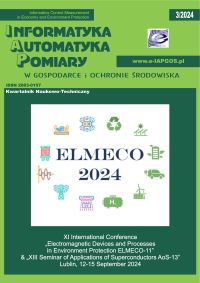MODELOWANIE MATEMATYCZNE I SYSTEM STEROWANIA BUDYNKIEM NIEMAL ZEROENERGETYCZNYM
Ildar A. Sultanguzin
sultanguzinia@mpei.ruNational Research University “MPEI”, Department of Industrial Thermal Engineering Systems (Federacja Rosyjska)
Hannes Toepfer
Technische Universität Ilmenau, Institute for Information Technology (Niemcy)
Ivan D. Kalyakin
National Research University “MPEI”, Department of Industrial Thermal Engineering Systems (Federacja Rosyjska)
Alexandr V. Govorin
National Research University “MPEI”, Department of Industrial Thermal Engineering Systems (Federacja Rosyjska)
Ekaterina V. Zhigulina
National Research University “MPEI”, Department of Industrial Thermal Engineering Systems (Federacja Rosyjska)
Sergey Yu. Kurzanov
National Research University “MPEI”, Department of Industrial Thermal Engineering Systems (Federacja Rosyjska)
Yury V. Yavorovsky
National Research University “MPEI”, Department of Industrial Thermal Engineering Systems (Federacja Rosyjska)
Abstrakt
W artykule rozważono trzy różne typy matematycznego modelu budynku o niemal zerowym zużyciu energii. Pierwszy model pozwala zoptymalizować strukturę i definicję kluczowych parametrów budynku energooszczędnego. Drugi model jest niezbędny do zaprojektowania domu pasywnego wykorzystującego odnawialne źródła energii. Trzeci model powinien być stosowany do godzinowego monitorowania i monitorowania systemu energetycznego budynku o niskim zużyciu energii przez cały rok.
Słowa kluczowe:
układ sterowania, model matematyczny, monitoring, dom pasywny, budynek zeroenergetycznyBibliografia
Bacher P., Madsen H., Nielsen H.A., Perers B.: Short-term heat load forecasting for single family houses. Energy and Buildings 38/2006, 63–71.
Google Scholar
Bacher P., Madsen H., Nielsen H.A.: Online short-term solar power forecasting. Solar Energy 83/2009, 1772–1783.
Google Scholar
Cemesova A. et al.: PassivBIM: Enhancing interoperability between BIM and low energy design software. Automation in Construction 57/2015, 17–32.
Google Scholar
Fabrizio E. et al.: A model to design and optimize multi-energy systems in buildings at the design concept stage. Renewable Energy 35/2010, 644–655.
Google Scholar
Fan Ch. et al.: Temporal knowledge discovery in big BAS data for building energy management. Energy and Buildings 109/2015, 75–89.
Google Scholar
Feist V.: Die Hauptlagen nach der Projektierung der passiven Häuser. Konti Print, Moscow 2015.
Google Scholar
Halvgaard R. et al.: Model predictive control for a smart solar tank based on weather and consumption forecasts. Energy Procedia 30/2012, 270–278.
Google Scholar
Michailidis I.T. et al.: Proactive control for solar energy exploitation: A german high-inertia building case study. Applied Energy 155/2015, 409–420.
Google Scholar
Oti A.H. et al.: A framework for the utilization of Building Management System data in building information models for building design and operation. Automation in Construction 72/2016, 195–210.
Google Scholar
Sultanguzin I., Kalyakin I., Govorin A., et.al.: Optimization of the energy efficient active house. 3 Ingenieurtag 2016. Neseff-Netzwerktreffen 2016. Tagungsband. Branden-burgische Technische Universität. Cottbus-Senftenberg. 14-15 November 2016, 8–12.
Google Scholar
Sultanguzin I.A., Isaev M.V., Kurzanov S.Yu.: Optimizing the production of coke, coal chemicals, and steel on the basis of environmental and energy criteria. Metallurgist 54/2011, 600–607.
Google Scholar
Toepfer H., Goetze M., Chervakova E., Hutschenreuther T.: On the Use of Wireless Sensors Within a Traffic Monitoring System. Proceedings of the International Academic Forum AMO–SPITSE–NESEFF. Smolensk Publishing “Universum”, Moscow–Smolensk 2016.
Google Scholar
Torunski E. et al.: A review of smart environments for energy savings. Procedia Computer Science 10/2012, 205–214.
Google Scholar
Wang Y., Kuckelkorn J., Liu Y.: State of art review on methodologies for control strategies in low energy buildings in the period from 2006 to 2016. Energy & Buildings 147/2017, 27–40.
Google Scholar
Zhou K. et al.: Big data driven smart energy management: From big data to big insights. Renewable and Sustainable Energy Reviews 56/2016, 215–225.
Google Scholar
Autorzy
Ildar A. Sultanguzinsultanguzinia@mpei.ru
National Research University “MPEI”, Department of Industrial Thermal Engineering Systems Federacja Rosyjska
Autorzy
Hannes ToepferTechnische Universität Ilmenau, Institute for Information Technology Niemcy
Autorzy
Ivan D. KalyakinNational Research University “MPEI”, Department of Industrial Thermal Engineering Systems Federacja Rosyjska
Autorzy
Alexandr V. GovorinNational Research University “MPEI”, Department of Industrial Thermal Engineering Systems Federacja Rosyjska
Autorzy
Ekaterina V. ZhigulinaNational Research University “MPEI”, Department of Industrial Thermal Engineering Systems Federacja Rosyjska
Autorzy
Sergey Yu. KurzanovNational Research University “MPEI”, Department of Industrial Thermal Engineering Systems Federacja Rosyjska
Autorzy
Yury V. YavorovskyNational Research University “MPEI”, Department of Industrial Thermal Engineering Systems Federacja Rosyjska
Statystyki
Abstract views: 237PDF downloads: 165
Licencja

Utwór dostępny jest na licencji Creative Commons Uznanie autorstwa – Na tych samych warunkach 4.0 Miedzynarodowe.








